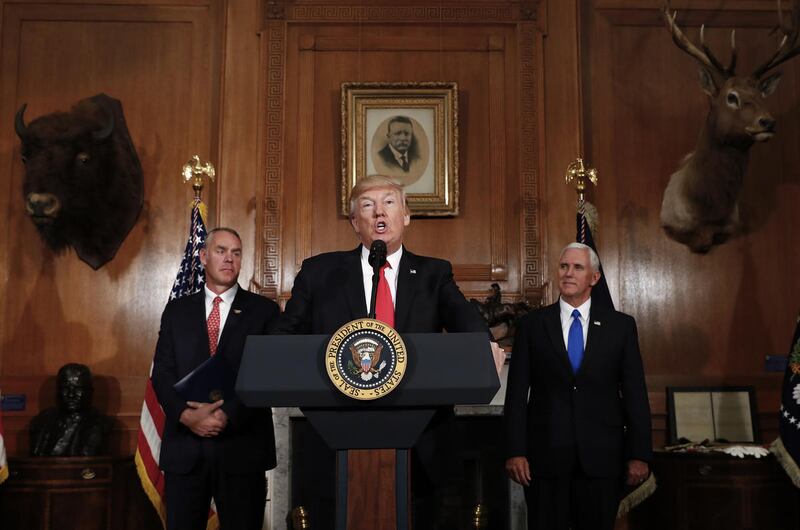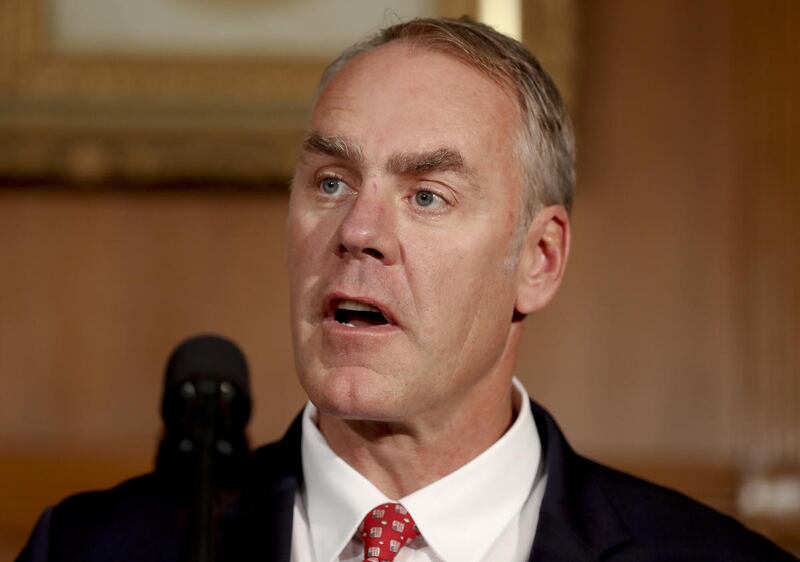SALT LAKE CITY — To all in the fight over the Bears Ears monument designation, there is much to win, a way of life to lose, and very little room on any side to compromise.
When Interior Secretary Ryan Zinke steps off the plane Sunday in Utah, he will become the key witness to a dramatic showdown over the fate of the 1.35 million-acre monument, and for the next several days, the man everyone in this fight will want to meet.
If the monument stands, Native Americans, environmental groups and conservation organizations that spent millions of dollars on the effort for a new monument in San Juan County can set about on the next steps.
Monument status elevates the cultural, historical and spiritual significance of the rugged country, they say, and puts federal land managers on a path to protecting thousands upon thousands of ancient artifacts.
A monument designation for the region gives five Native American tribes not only a reason to celebrate, but a reason to hope that strong bonds will be forged with an American government that over centuries has let them down at best or betrayed them at worst.
To these Native American men and women who fight for the survival of the Bears Ears National Monument, it assures their spiritual connection there will live on, cradled in the arms of wind-swept buttes, pine-dotted mountaintops and sprawling Cedar Mesa sandstone.
But a loud chorus of people in San Juan County say they love the land as well, but hate the monument.
They're offended that a place hailed for its beauty and solitude suddenly needs an absentee landlord in Washington, D.C., to exercise oversight when generations have grown up with it as their backyard.
Regardless of the promises in President Barack Obama's Bears Ears proclamation, they see monument status as the wedge in the door of access that the federal government will eventually slam shut.
They fear hunting, fishing, grazing, collecting firewood, motorized travel — multiple uses of the land — will be chipped away and restricted until the activities are eventually gone. In their place will rise a Moab-esq atmosphere with monument signs, a visitor center, lines of cars and hoards of selfie-taking tourists intent on scratching one more destination off their to-do list.
With 65 percent of land within Utah's borders already owned and controlled by the federal government, the state's leaders and county governments are indignant that one more layer of government control — over their objections — was hoisted upon a county that is already the poorest in the state, where jobs are already tough to come by.
Against this backdrop, Zinke — a former Navy Seal Team Six leader — will wade into the fray by visiting Bears Ears and meeting with local residents before he returns to Washington, D.C., to eventually advise President Donald Trump on what its fate should be.
"The fact that he has agreed to come and visit, I think, is a good thing for everybody," Gov. Gary Herbert said. "He needs to come and look at the public lands issues we have here in the Intermountain West and particularly in Utah. He needs to look at some of the areas of controversy. I think he needs to come with an open mind and an unbiased attitude, and take a look and listen to the pros and cons."
Zinke's visit to the Bears Ears and Grand Staircase-Escalante national monuments — also under fire but in a blaze that was set 21 years ago when it was created — comes as a result of an executive order issued by President Trump on April 26.
That order directs a 45-day review centered around Bears Ears with resulting recommendations for the president, as well as a look at designations of monuments with more than 100,000 acres since 1996.
With a sympathetic president at the helm who campaigned on the promise to return power to the states and power to the people — and also unravel federal regulations — Utah's leaders are practically giddy at the prospect there will be some sort of presidential directive on Bears Ears.
While no president has ever rescinded a monument, and therefore that executive power has never been tested in court, five presidents have significantly reduced monuments. In the most extreme example, President Howard Taft reduced the Navajo National Monument by 89 percent.
Over time, 11 national monuments have been abolished through acts of Congress, according to the National Park Service, most typically because their importance was overstated or the resources for which they were established were diminished.
In Utah, a legal battle raged to overturn Grand Staircase-Escalante National Monument, but that proved unsuccessful.
History, then, offers a mosaic of executive branch and congressional reactions to controversial monument creations.
For supporters of Bears Ears, a rescission is akin to blasphemy — and any reduction in size as a so-called "compromise" is untenable.
"Friends of Cedar Mesa is committed to on-the-ground stewardship of these public lands whatever the politicians decide," said Josh Ewing, the group's executive director. "However, any shrinkage of the monument just makes it that much harder for us to do good stewardship to benefit the landscape as we're forced into legal/political/policy battles to stop bad things from happening to lands that should have been protected in the first place."
Jami Bayles, president of Stewards of San Juan County, said the designation goes against what residents want and won't automatically come with protections supporters want. The monument designation needs to go.
"It is appalling that nonlocal voices have drowned out those who treasure this land the most. Long before established bureaus arrived, it was and has always been the local people who have protected and cared for this land. We are the reason it is pristine," Bayles said.



